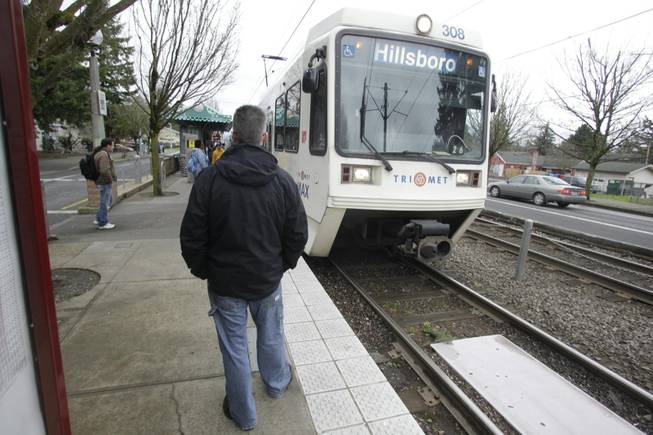
AP
Scott Nielsen waits for a train at the TriMet light rail stop at 162nd Avenue Wednesday, March 30, 2011, in Portland, Ore.
Wednesday, Nov. 14, 2018 | 2 a.m.
View more of the Sun's opinion section
With new members coming soon to the Clark County Commission, here’s a challenge not only for the incoming commissioners but for the group as a whole:
Put your foot to the floor on development of light rail, and keep it there.
The problems with solving Southern Nevada’s chronic traffic congestion by other means reared their heads once again last month with the county’s proposal to build elevated roadways to carry traffic between McCarran International Airport and the Strip.
Predictably, the plans drew concern from UNLV, where the elevated roads would run along the southwestern border of campus — more specifically, over the intersection of Tropicana Avenue and Swenson Street.
University officials are worried about how the project would affect the movement of traffic for classes and events at the Thomas & Mack Center, but a bigger concern comes down to this: UNLV doesn’t want an unsightly overpass running through its front porch.
That’s justifiable. Architectural renderings of the project show that views of the university would be blocked along stretches of the roadways underneath the overpass, while the new roadways would clutter the view from campus.
And those are just UNLV’s concerns. Residents living near the project stand to suffer losses in their property values, for example, as it’s safe to say that most people don’t want to live in the shadow of an overpass. Plus, elevated roadways tend to give rise to littering, graffiti, and even homeless camps and crime.
That’s why cities around the world are tearing down elevated expressways instead of building them.
Commission Chairman Steve Sisolak, to his credit, put the brakes on the project after UNLV brought forward its concerns. Sisolak, who is leaving the commission after being elected Nevada governor last week, asked that the proposal be put on hold to allow UNLV to finish a study on how it would affect the university.
That was a responsible move, and here’s hoping the county and university can work things out.
But the bigger problem here is that more roads aren’t the answer to the region’s traffic problems, particularly the congestion between the airport and the Strip.
Given that the streets can’t be widened at either end — at McCarran or on Las Vegas Boulevard — it’s a losing cause to put more cars into the mix. No matter how easy it might be to drive between the destinations, traffic is going to jam up upon arrival.
That being the case, it’s critical for the county to concentrate on light rail.
This is about more than convenience for motorists. It’s about maintaining our status as an international travel destination and keeping our economy humming.
With Las Vegas marketing its visitor experience more than any single element of tourism — gaming, entertainment or shopping, for instance — we need to ensure that the experience remains pleasant. Providing a convenient, quick and cheap way for tourists and convention visitors to get around would go a long way in that regard.
Conversely, packing more cars onto the road will result in more time spent in bumper-to-bumper traffic, which is nobody’s idea of fun.
For residents, and especially for people who work along the Strip, a light rail system complete with park-and-ride lots would provide a quick way to get to work or go out in the tourist corridor. And even for those who prefer to drive to the Strip and park there, it would help by reducing car traffic among tourists.
Another key reason for light rail is competitive in nature. Other cities, including Phoenix, Denver and Orlando, Fla., have embraced it and are expanding their systems, while Las Vegas stays stuck with a transportation model from the days of land-line telephones. Which city would you rather visit — one where you get stuck in traffic, or one with a system that allows you to quickly zip around town and eliminates the need to rent a car or use a ride-hailing app?
On the other end of the equation, light rail systems have been proven to drive up nearby property values and spur significant development.
As officials move forward on a proposed light rail system connecting Maryland Parkway to downtown Las Vegas and the medical district, county leaders should be pressing for development of a Strip system as well.
Both of the county commission’s incoming members, Tick Segerblom and Justin Jones, have presented themselves as strong supporters of public transportation, which is encouraging. It also boded well that Jim Gibson, a pragmatic Democrat, was elected to his first term on the commission after being appointed last year.
We urge the three to follow up their election with strong leadership on light rail.
With the Strip’s traffic problems having reached critical mass, Southern Nevada is in need of a transformation. After last week’s election, this is a prime opportunity to get that transformation underway.
